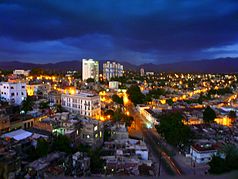
Back Santiago de Cuba Afrikaans Santiago de Cuba AN سانتياغو دي كوبا (مدينة) Arabic سانتياجو دى كوبا ARZ Santiago de Cuba AST Сант’яга-дэ-Куба Byelorussian Сант’яга-дэ-Куба BE-X-OLD Сантяго де Куба Bulgarian Santiago de Cuba Breton Santiago de Cuba Catalan
Santiago de Cuba
Santiago de Cuba | |
|---|---|
From top down: Aerial view of the city during nighttime, the Metropolitan Cathedral of Santiago de Cuba, the city welcome sign with the city's motto. | |
| Motto(s): Rebelde ayer, hospitalaria hoy, heroica siempre (Spanish) ("Rebellious yesterday, hospitable today, always heroic") | |
 Santiago municipality (red) within Santiago Province (yellow) and Cuba | |
| Coordinates: 20°01′18″N 75°49′46″W / 20.02167°N 75.82944°W | |
| Country | Cuba |
| Province | Santiago de Cuba |
| Established | 1515 |
| Founded by | Diego Velázquez de Cuéllar |
| Government | |
| • Mayor | Yaneydis Batista Hechavarría |
| Area | |
| • Municipality | 1,023.8 km2 (395.3 sq mi) |
| Elevation | 82 m (269 ft) |
| Population (2022) | |
| 507,167 | |
| • Urban | 451,528 |
| • Rural | 55,639 |
| Demonym | santiaguero/a |
| GDP (PPP, constant 2015 values) | |
| • Year | 2023 |
| • Total | $6.2 billion[1] |
| • Per capita | $14,000 |
| Area code | +53 22 |
| Website | www |
Santiago de Cuba is the second-largest city in Cuba and the capital city of Santiago de Cuba Province. It lies in the southeastern area of the island, some 870 km (540 mi) southeast of the Cuban capital of Havana.
The municipality extends over 1,023.8 km2 (395.3 sq mi),[2] and contains the communities of Antonio Maceo, Bravo, Castillo Duany, Daiquirí, El Caney, El Cobre, El Cristo, Guilera, Leyte Vidal, Moncada and Siboney.[3]
Historically Santiago de Cuba was the second-most important city on the island after Havana, and remains the second-largest. It is on a bay connected to the Caribbean Sea and an important sea port. In the 2022, the city of Santiago de Cuba recorded a population of 507,167 people.[4]
- ^ "TelluBase—Cuba Fact Sheet" (PDF). Tellusant. Retrieved 2024-01-11.
- ^ Santiago.cu (2006). "Municipalities of Santiago de Cuba" (in Spanish). Archived from the original on 15 December 2007. Retrieved 5 October 2007.
- ^ Guije.com. "Palma Soriano" (in Spanish). Archived from the original on 30 September 2007. Retrieved 5 October 2007.
- ^ "Santiago de Cuba (Municipality, Cuba) - Population Statistics, Charts, Map and Location". www.citypopulation.de. Retrieved 2024-02-01.




